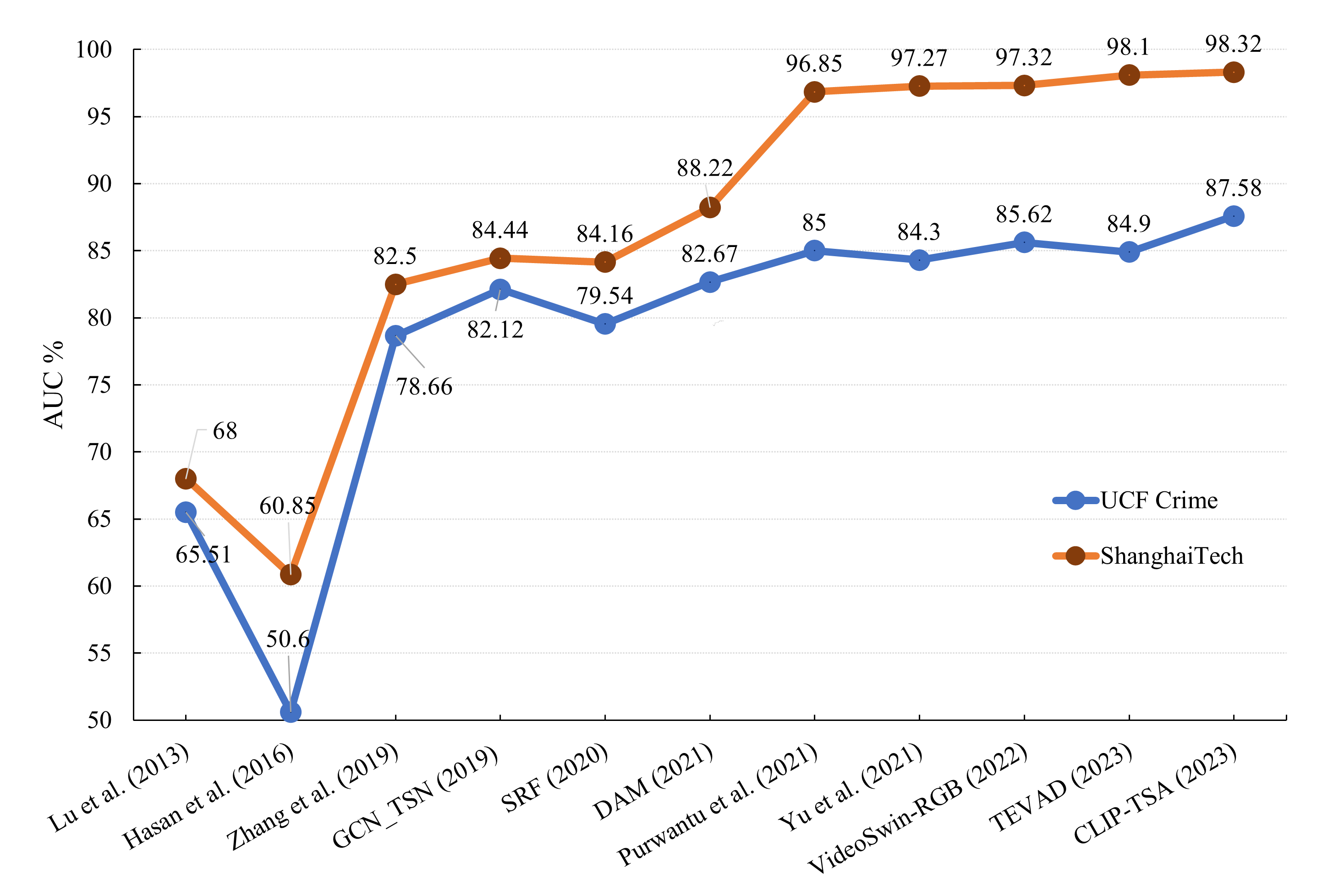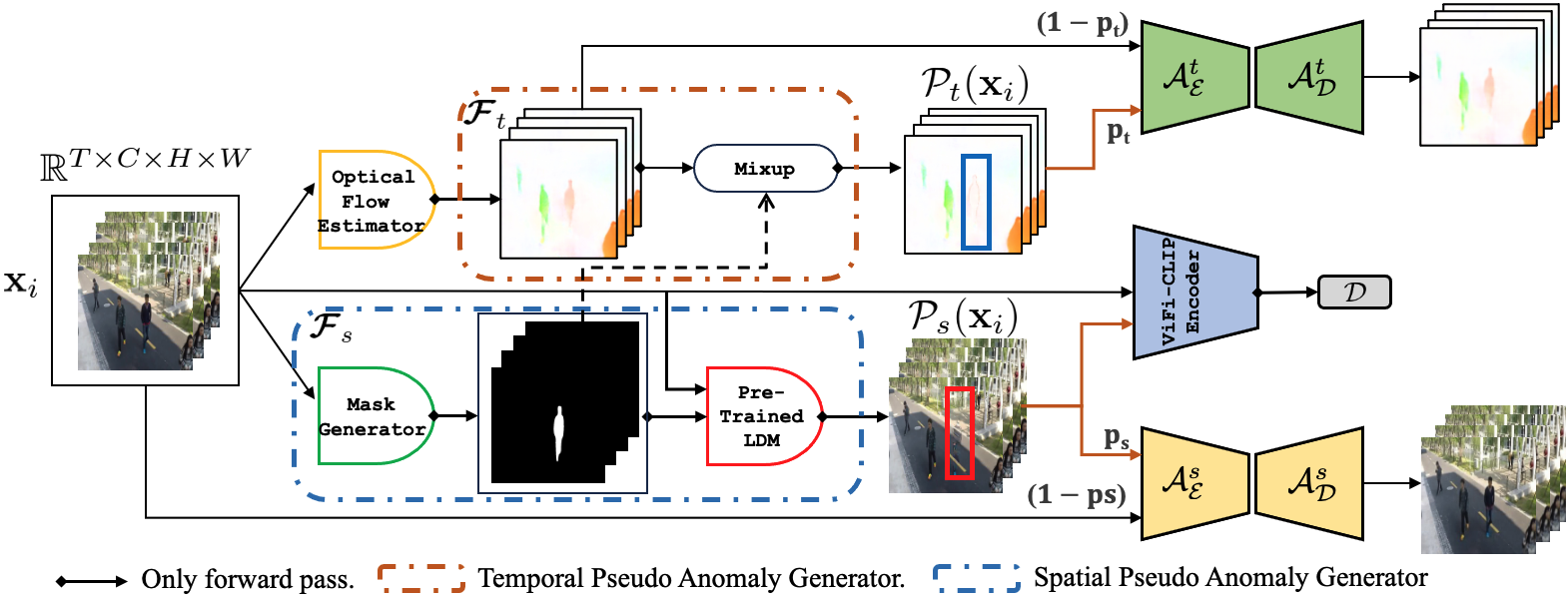Deep Learning for Video Anomaly Detection: A Review

0

Sign in to get full access
Overview
- This paper provides a comprehensive review of deep learning-based approaches for video anomaly detection.
- Video anomaly detection is the task of identifying unusual or unexpected events in video data.
- Deep learning has emerged as a powerful tool for this problem, with significant advancements in recent years.
Plain English Explanation
Video anomaly detection is all about spotting unusual things happening in video footage. Imagine you have a security camera watching a busy office, and most of the time you see people coming and going, making copies, and chatting around the water cooler - that's the normal, everyday stuff. But every once in a while, something strange might happen, like someone rushing out with a big box or a fight breaking out. Those are the anomalies, the things that don't fit the usual pattern.
Deep learning is a type of artificial intelligence that's really good at recognizing patterns in data, and researchers have been using it to tackle the problem of video anomaly detection. By training deep learning models on lots of normal video footage, they can teach the models to recognize what's typical, and then the models can flag anything that seems out of the ordinary.
This review paper looks at all the different ways researchers have been using deep learning for this task. They cover things like how the models are designed, what kind of data they're trained on, and the techniques they use to spot anomalies. The goal is to give readers a comprehensive understanding of the state-of-the-art in this rapidly evolving field.
Technical Explanation
The paper begins by providing background on the video anomaly detection problem and highlighting the advantages of using deep learning approaches. [^1] Deep learning models, such as convolutional neural networks (CNNs) and recurrent neural networks (RNNs), have shown impressive performance in tasks like image and video classification, making them well-suited for video anomaly detection.
The authors then discuss the key components of deep learning-based video anomaly detection systems. [^2] This includes the input representation (e.g., raw frames, optical flow, spatiotemporal features), the model architecture (e.g., autoencoder, generative adversarial network, long short-term memory), and the training and inference procedures (e.g., reconstruction error, adversarial loss, anomaly score).
The paper also reviews various datasets and evaluation metrics that are commonly used in this field, [^3] as well as recent advancements in areas like weakly-supervised, few-shot, and online learning for video anomaly detection. [^4]
Critical Analysis
The paper provides a thorough and up-to-date review of the state-of-the-art in deep learning-based video anomaly detection. It highlights the significant progress that has been made in this field, with deep learning models outperforming traditional approaches in many benchmarks.
However, the authors also acknowledge some of the limitations and challenges of existing deep learning methods. [^5] For example, they note that these models can be sensitive to dataset bias, may struggle with rare or complex anomalies, and often require large amounts of annotated training data, which can be costly to obtain.
The paper also suggests several promising directions for future research, such as exploring more efficient architectures, incorporating additional modalities (e.g., audio, text), and developing unsupervised or few-shot learning techniques to reduce the reliance on labeled data. [^6]
Conclusion
This comprehensive review paper provides a valuable resource for researchers and practitioners working on video anomaly detection. By summarizing the key advancements in deep learning-based approaches, the authors help readers understand the current state of the art and identify areas for future exploration. The paper's thorough technical explanation, combined with its plain-language overview, makes it accessible to a wide audience interested in the latest developments in this important and challenging computer vision problem.
[^1]: See the Background section for an overview of the video anomaly detection problem and the advantages of deep learning. [^2]: Refer to the Technical Explanation section for details on the key components of deep learning-based video anomaly detection systems. [^3]: The paper discusses datasets and evaluation metrics in the Background section. [^4]: The latest advancements in areas like weakly-supervised, few-shot, and online learning are covered in the Technical Explanation section. [^5]: The Critical Analysis section outlines some of the limitations and challenges of existing deep learning methods for video anomaly detection. [^6]: The Critical Analysis section also discusses promising directions for future research in this field.
This summary was produced with help from an AI and may contain inaccuracies - check out the links to read the original source documents!
Related Papers


0
Deep Learning for Video Anomaly Detection: A Review
Peng Wu, Chengyu Pan, Yuting Yan, Guansong Pang, Peng Wang, Yanning Zhang
Video anomaly detection (VAD) aims to discover behaviors or events deviating from the normality in videos. As a long-standing task in the field of computer vision, VAD has witnessed much good progress. In the era of deep learning, with the explosion of architectures of continuously growing capability and capacity, a great variety of deep learning based methods are constantly emerging for the VAD task, greatly improving the generalization ability of detection algorithms and broadening the application scenarios. Therefore, such a multitude of methods and a large body of literature make a comprehensive survey a pressing necessity. In this paper, we present an extensive and comprehensive research review, covering the spectrum of five different categories, namely, semi-supervised, weakly supervised, fully supervised, unsupervised and open-set supervised VAD, and we also delve into the latest VAD works based on pre-trained large models, remedying the limitations of past reviews in terms of only focusing on semi-supervised VAD and small model based methods. For the VAD task with different levels of supervision, we construct a well-organized taxonomy, profoundly discuss the characteristics of different types of methods, and show their performance comparisons. In addition, this review involves the public datasets, open-source codes, and evaluation metrics covering all the aforementioned VAD tasks. Finally, we provide several important research directions for the VAD community.
Read more9/10/2024


0
Video Anomaly Detection in 10 Years: A Survey and Outlook
Moshira Abdalla, Sajid Javed, Muaz Al Radi, Anwaar Ulhaq, Naoufel Werghi
Video anomaly detection (VAD) holds immense importance across diverse domains such as surveillance, healthcare, and environmental monitoring. While numerous surveys focus on conventional VAD methods, they often lack depth in exploring specific approaches and emerging trends. This survey explores deep learning-based VAD, expanding beyond traditional supervised training paradigms to encompass emerging weakly supervised, self-supervised, and unsupervised approaches. A prominent feature of this review is the investigation of core challenges within the VAD paradigms including large-scale datasets, features extraction, learning methods, loss functions, regularization, and anomaly score prediction. Moreover, this review also investigates the vision language models (VLMs) as potent feature extractors for VAD. VLMs integrate visual data with textual descriptions or spoken language from videos, enabling a nuanced understanding of scenes crucial for anomaly detection. By addressing these challenges and proposing future research directions, this review aims to foster the development of robust and efficient VAD systems leveraging the capabilities of VLMs for enhanced anomaly detection in complex real-world scenarios. This comprehensive analysis seeks to bridge existing knowledge gaps, provide researchers with valuable insights, and contribute to shaping the future of VAD research.
Read more7/2/2024
❗

0
Advancing Video Anomaly Detection: A Concise Review and a New Dataset
Liyun Zhu, Lei Wang, Arjun Raj, Tom Gedeon, Chen Chen
Video Anomaly Detection (VAD) finds widespread applications in security surveillance, traffic monitoring, industrial monitoring, and healthcare. Despite extensive research efforts, there remains a lack of concise reviews that provide insightful guidance for researchers. Such reviews would serve as quick references to grasp current challenges, research trends, and future directions. In this paper, we present such a review, examining models and datasets from various perspectives. We emphasize the critical relationship between model and dataset, where the quality and diversity of datasets profoundly influence model performance, and dataset development adapts to the evolving needs of emerging approaches. Our review identifies practical issues, including the absence of comprehensive datasets with diverse scenarios. To address this, we introduce a new dataset, Multi-Scenario Anomaly Detection (MSAD), comprising 14 distinct scenarios captured from various camera views. Our dataset has diverse motion patterns and challenging variations, such as different lighting and weather conditions, providing a robust foundation for training superior models. We conduct an in-depth analysis of recent representative models using MSAD and highlight its potential in addressing the challenges of detecting anomalies across diverse and evolving surveillance scenarios. Our dataset is available here.
Read more6/28/2024


0
Video Anomaly Detection via Spatio-Temporal Pseudo-Anomaly Generation : A Unified Approach
Ayush K. Rai, Tarun Krishna, Feiyan Hu, Alexandru Drimbarean, Kevin McGuinness, Alan F. Smeaton, Noel E. O'Connor
Video Anomaly Detection (VAD) is an open-set recognition task, which is usually formulated as a one-class classification (OCC) problem, where training data is comprised of videos with normal instances while test data contains both normal and anomalous instances. Recent works have investigated the creation of pseudo-anomalies (PAs) using only the normal data and making strong assumptions about real-world anomalies with regards to abnormality of objects and speed of motion to inject prior information about anomalies in an autoencoder (AE) based reconstruction model during training. This work proposes a novel method for generating generic spatio-temporal PAs by inpainting a masked out region of an image using a pre-trained Latent Diffusion Model and further perturbing the optical flow using mixup to emulate spatio-temporal distortions in the data. In addition, we present a simple unified framework to detect real-world anomalies under the OCC setting by learning three types of anomaly indicators, namely reconstruction quality, temporal irregularity and semantic inconsistency. Extensive experiments on four VAD benchmark datasets namely Ped2, Avenue, ShanghaiTech and UBnormal demonstrate that our method performs on par with other existing state-of-the-art PAs generation and reconstruction based methods under the OCC setting. Our analysis also examines the transferability and generalisation of PAs across these datasets, offering valuable insights by identifying real-world anomalies through PAs.
Read more4/9/2024